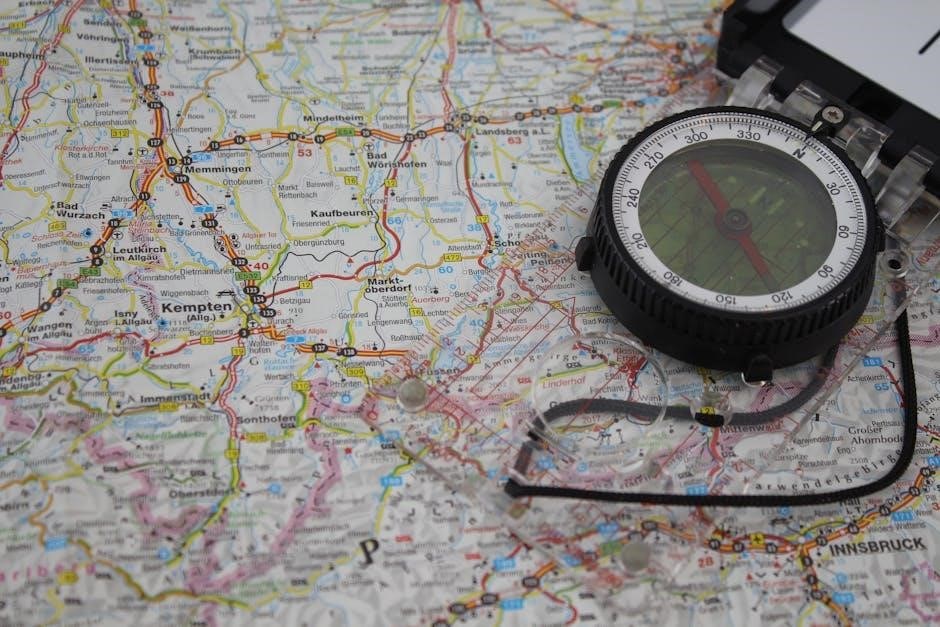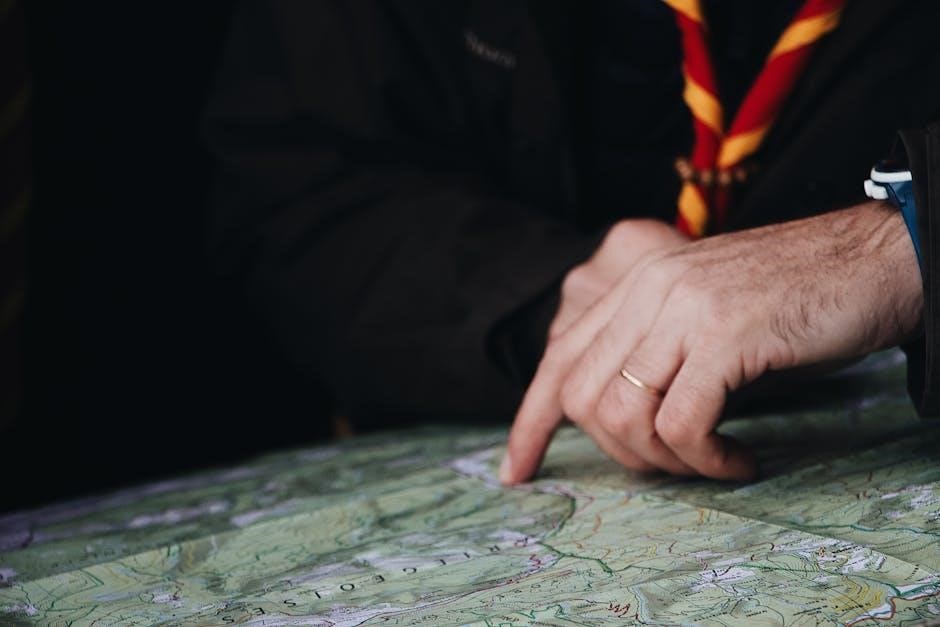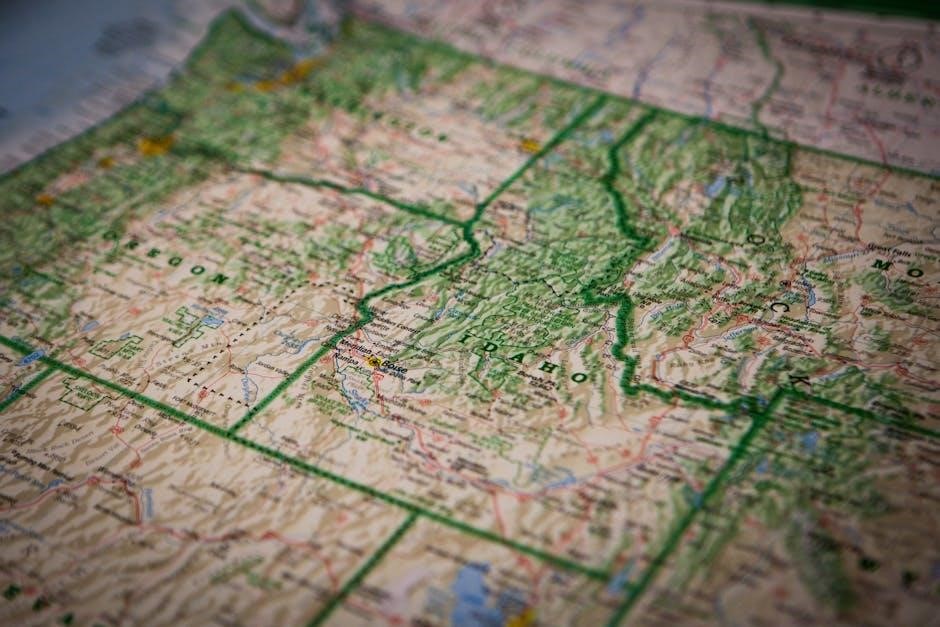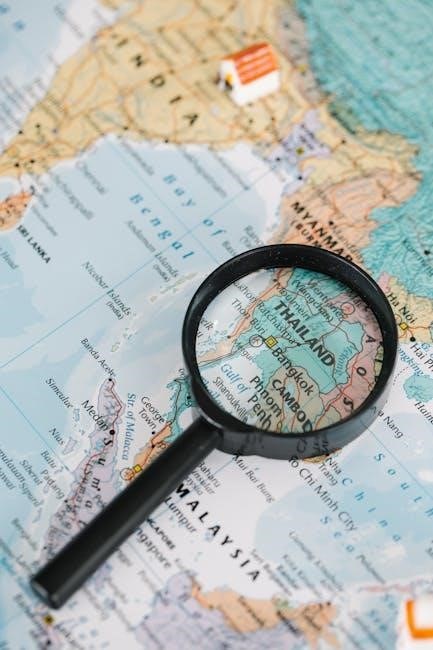The AQA GCSE Geography course introduces students to a comprehensive understanding of physical and human geography‚ focusing on key themes‚ case studies‚ and essential skills for analytical thinking.
1.1. Overview of the AQA GCSE Geography Curriculum
The AQA GCSE Geography curriculum is structured to provide a balanced understanding of physical and human geography. It covers key topics such as natural hazards‚ ecosystems‚ physical landscapes‚ urban challenges‚ and global economic changes. Students explore real-world case studies and develop essential skills like analytical thinking and problem-solving. The course is divided into manageable sections‚ each focusing on specific themes and processes. Emphasis is placed on understanding human-environment interactions and the impact of globalisation. Practical skills‚ such as map-reading and data analysis‚ are also integrated. The curriculum aims to prepare students for independent thinking and equip them with knowledge relevant to contemporary geographical issues.
1.2. Key Components of the Course
The AQA GCSE Geography course is divided into physical and human geography‚ with a strong emphasis on case studies‚ fieldwork‚ and practical skills. Key components include understanding natural hazards‚ ecosystems‚ urban challenges‚ and global economic changes. Students learn to interpret maps‚ graphs‚ and data‚ developing analytical and problem-solving abilities. The course also focuses on human-environment interactions‚ such as deforestation and urbanisation‚ and their impacts on sustainability. Practical skills‚ like conducting fieldwork and using Geographical Information Systems (GIS)‚ are integral to the curriculum. These components collectively prepare students for independent study and real-world applications‚ ensuring a well-rounded understanding of geographical concepts and their relevance to contemporary issues.
1.3. Importance of Revision in AQA GCSE Geography
Revision is crucial for success in AQA GCSE Geography‚ as it helps students master key concepts‚ case studies‚ and skills. Regular review ensures understanding of complex topics like natural hazards‚ ecosystems‚ and urban challenges. Effective revision strategies‚ such as using past papers‚ flashcards‚ and mind maps‚ enhance retention and exam performance. Practicing essay questions and multiple-choice answers improves time management and confidence. Revision also highlights areas needing extra focus‚ allowing targeted study. Utilizing resources like revision guides‚ online tools‚ and teacher advice maximizes results. Consistent and organized revision builds familiarity with the curriculum‚ reducing exam anxiety and fostering a deeper understanding of geographical principles and their real-world applications.

The Challenge of Natural Hazards
Natural hazards like earthquakes‚ volcanoes‚ and extreme weather pose significant threats to communities. Understanding their causes‚ impacts‚ and management strategies is vital for mitigation and sustainable development globally.
2.1. Tectonic Hazards: Earthquakes and Volcanoes
Tectonic hazards‚ including earthquakes and volcanic eruptions‚ are significant natural disasters shaped by plate tectonics. Earthquakes occur due to the release of energy as tectonic plates move‚ causing ground shaking and tremors. Volcanic activity results from magma rising to the Earth’s surface‚ often linked to subduction zones. Both hazards pose risks to human life‚ infrastructure‚ and the environment. Understanding their causes‚ such as fault lines and magma movement‚ is crucial for prediction and mitigation. Case studies like Japan and Iceland highlight how communities adapt and respond to these challenges‚ emphasizing the importance of early warning systems‚ evacuation plans‚ and resilient infrastructure to reduce disaster impacts.
2.2. Weather Hazards: Tropical Storms and Extreme Weather Events
Weather hazards‚ such as tropical storms and extreme weather events‚ pose significant threats to communities globally. Tropical storms‚ including hurricanes and typhoons‚ form over warm oceans‚ driven by heat and moisture. They bring intense rainfall‚ strong winds‚ and storm surges‚ causing flooding and coastal erosion. Extreme weather events‚ like heatwaves and heavy rainfall‚ are increasingly linked to climate change. Understanding the formation‚ impacts‚ and mitigation strategies for these hazards is crucial. Case studies highlight the importance of early warning systems‚ evacuation plans‚ and resilient infrastructure to reduce vulnerability and protect populations from the devastating effects of these weather-related disasters.
2.3. Managing Natural Hazards: Strategies and Case Studies
Managing natural hazards requires a combination of strategies‚ including prediction‚ prevention‚ and mitigation. Early warning systems‚ such as those used for tornadoes or tsunamis‚ enable evacuations and reduce casualties. Infrastructure like flood defenses and earthquake-resistant buildings can minimize damage. Case studies‚ such as Japan’s response to the 2011 Tohoku earthquake‚ highlight the importance of preparedness and community education. Sustainable land-use planning and international cooperation also play key roles. Examples from the Netherlands’ flood management and the U.S.’s hurricane preparedness demonstrate effective strategies. These approaches aim to reduce vulnerability‚ protect lives‚ and promote long-term resilience in the face of natural disasters.

The Living World
Explores ecosystems‚ conservation efforts‚ and human impacts on the environment‚ focusing on biodiversity‚ sustainable practices‚ and the delicate balance between natural and human-influenced landscapes globally.
3.1. Ecosystems: Tropical Rainforests and Hot Deserts
Tropical rainforests and hot deserts are two contrasting ecosystems studied in AQA GCSE Geography. Rainforests‚ such as the Amazon‚ are lush‚ biodiverse habitats with dense vegetation and high rainfall. Hot deserts‚ like the Sahara‚ are arid‚ with limited vegetation and extreme temperatures. Both ecosystems support unique wildlife adapted to their environments; Key topics include the water cycle‚ nutrient cycles‚ and the impact of human activities‚ such as deforestation and climate change. Understanding these ecosystems helps students appreciate biodiversity conservation and the importance of sustainable practices to protect these vital environments for future generations. These studies form a core part of the Living World unit.
3.2. Conservation Efforts: Protecting Biodiversity
Conservation efforts are critical to protecting biodiversity‚ a key theme in AQA GCSE Geography. Strategies include habitat restoration‚ species protection‚ and sustainable practices. National parks and wildlife reserves safeguard ecosystems‚ while international agreements like CITES regulate trade. Community involvement and education play vital roles. Technologies such as camera traps and satellite monitoring aid enforcement. Economic incentives‚ like ecotourism‚ encourage local support; Students learn about success stories‚ such as giant panda conservation‚ and challenges like funding and poaching. Effective conservation balances human needs with environmental protection‚ ensuring biodiversity for future generations. These efforts are essential for maintaining ecosystems and addressing global environmental issues.
3.3. Human Impact on the Environment: Deforestation and Desertification
Human activities significantly impact the environment‚ with deforestation and desertification being major concerns. Deforestation‚ often due to agriculture‚ logging‚ and urban expansion‚ leads to biodiversity loss and increased greenhouse gas emissions. Desertification‚ exacerbated by overgrazing and climate change‚ results in soil degradation and reduced agricultural productivity. Both issues threaten global food security and ecosystems. Case studies‚ such as the Amazon rainforest and the Sahel region‚ highlight these challenges. Sustainable practices‚ like reforestation and soil conservation‚ are essential to mitigate these impacts. Understanding these processes is crucial for developing strategies to protect the environment and promote sustainable development. These topics are key in AQA GCSE Geography studies.

Physical Landscapes in the UK
The UK’s diverse physical landscapes include coasts‚ rivers‚ and glaciated areas‚ each shaped by unique geological processes. These landscapes significantly influence the environment and human activities‚ forming a key part of the AQA GCSE Geography curriculum.
4.1. Coasts: Landforms and Processes
Coastal landscapes are shaped by the interaction of marine and terrestrial processes. Key landforms include cliffs‚ bays‚ beaches‚ spits‚ and bars‚ formed through erosion and deposition. Wave action‚ tides‚ and currents play a crucial role in shaping these features. Erosional processes‚ such as hydraulic action and abrasion‚ create dramatic cliffs and arches‚ while depositional processes build up beaches and spits. Human activities‚ such as coastal protection and tourism‚ significantly impact these dynamic environments. Understanding these processes is vital for managing coastal ecosystems and mitigating the effects of erosion and flooding. Case studies‚ like Dawlish Warren in Devon‚ illustrate these principles in action.
4.2. Rivers: River Landforms and Flood Management
Rivers shape landscapes through erosion‚ transportation‚ and deposition‚ creating distinctive landforms like valleys‚ meanders‚ and deltas. Meanders form due to the erosional action of rivers on the outer bends and deposition on the inner bends. Floodplains develop over time‚ providing fertile agricultural land but also posing flood risks. Flood management strategies include hard engineering‚ such as dams and levees‚ and soft engineering‚ like wetland restoration. Case studies‚ such as the River Thames and its flood management systems‚ illustrate these concepts. Understanding river processes and management techniques is essential for balancing human needs with environmental sustainability in riverine ecosystems.
4.3. Glaciated Landscapes: Features and Processes
Glaciated landscapes are shaped by the erosional and depositional actions of glaciers‚ creating distinctive landforms such as U-shaped valleys‚ glacial troughs‚ and arêtes. Glacial processes like plucking and abrasion carve out these features‚ while moraines and drumlins are formed from deposited glacial materials. In high-latitude or mountainous regions‚ such as the Lake District or Norway‚ these landforms dominate the scenery. Understanding how glaciers shape and transform landscapes is vital for analyzing the impact of past and present glacial activity. Case studies of glacial regions provide insights into these geological processes‚ enabling students to interpret and describe glaciated landscapes effectively in their GCSE Geography studies.

Urban Issues and Challenges
Urban areas face challenges like overcrowding‚ pollution‚ and inequality‚ driven by rapid urbanization. Strategies for sustainable development and regeneration are crucial to address these growing urban issues effectively.
5.1. Urbanisation: Causes and Consequences
Urbanisation refers to the rapid growth of cities due to migration from rural to urban areas. Key causes include economic opportunities‚ improved services‚ and escaping rural poverty. Consequences are diverse: urban areas drive economic growth‚ foster cultural diversity‚ and innovate‚ but they also face challenges like overcrowding‚ pollution‚ and inequality. Urbanisation strains resources‚ leading to housing shortages and social tensions. Managing these issues requires sustainable planning‚ infrastructure development‚ and policies to ensure inclusive growth. Understanding these dynamics is crucial for addressing urban challenges effectively in both developed and developing regions.
5.2. Urban Renewal and Regeneration Strategies
Urban renewal and regeneration strategies aim to revitalize declining urban areas through targeted interventions. These strategies often involve mixed-use developments‚ public transport improvements‚ and green space creation to enhance livability. Governments and planners prioritize sustainable urban development‚ incorporating renewable energy and eco-friendly designs. Community engagement is crucial‚ ensuring local residents benefit from initiatives. Regeneration projects address social and economic disparities‚ promoting inclusivity and reducing inequality. By fostering investment and innovation‚ these strategies aim to create vibrant‚ adaptable cities that meet the needs of future generations while preserving heritage and cultural identity. Effective urban renewal balances economic growth with environmental and social sustainability.
5.3. Sustainable Urban Development: Case Studies
Sustainable urban development focuses on creating eco-friendly‚ inclusive‚ and resilient cities. Case studies like Copenhagen’s carbon neutrality project and Barcelona’s superblocks initiative highlight innovative approaches. Copenhagen aims to be carbon neutral by 2025‚ integrating green roofs‚ bike-friendly infrastructure‚ and district heating systems. Barcelona’s superblocks reduce traffic‚ prioritizing pedestrian spaces and green areas‚ improving air quality and community interaction. Curitiba‚ Brazil‚ is renowned for its Bus Rapid Transit system‚ enhancing public transport efficiency and reducing urban sprawl. These examples demonstrate how sustainable practices‚ such as renewable energy integration and community engagement‚ can transform cities‚ promoting environmental‚ social‚ and economic well-being for future generations.

The Changing Economic World
This section explores globalisation‚ economic development‚ and the role of transnational corporations (TNCs) in shaping economies. It examines how globalisation impacts communities and economies worldwide.
6.1. Globalisation: Impacts on Economies and Communities
Globalisation has profoundly shaped economies and communities worldwide. It fosters economic growth through increased trade‚ investment‚ and job creation‚ particularly in developing countries. Transnational corporations (TNCs) drive this process‚ expanding markets and integrating economies. However‚ globalisation also leads to inequality‚ as wealth often concentrates in developed nations. Local industries may decline due to competition from global firms. Culturally‚ globalisation promotes homogenisation‚ potentially eroding traditional practices. Communities may face challenges like job displacement and cultural loss‚ while benefiting from access to new technologies and goods. This dual impact highlights the complex nature of globalisation‚ requiring balanced strategies to maximise benefits and mitigate negative effects.
6.2. Economic Development: NICs and LICs
Economic development varies significantly between Newly Industrialised Countries (NICs) and Less Industrialised Countries (LICs). NICs‚ such as South Korea and Brazil‚ have advanced manufacturing sectors‚ robust infrastructure‚ and growing middle classes‚ enabling them to compete globally. In contrast‚ LICs‚ like many sub-Saharan African nations‚ rely heavily on agriculture and raw material exports‚ often facing challenges like poverty and limited infrastructure. NICs typically attract foreign investment and implement policies that foster industrial growth‚ while LICs struggle with barriers such as political instability and lack of access to technology. These differences highlight the uneven nature of global economic development and the challenges LICs face in catching up with NICs.
6.3. The Role of TNCs in the Global Economy
Transnational Corporations (TNCs) play a pivotal role in shaping the global economy by operating across multiple countries. They invest in foreign markets‚ creating jobs and stimulating economic growth‚ particularly in developing nations. TNCs drive globalisation by outsourcing production to regions with lower labour costs‚ enhancing efficiency and profitability. However‚ their dominance can lead to exploitation‚ as they often prioritise profits over local welfare and environmental sustainability. TNCs also influence global trade patterns and technological advancement‚ making them key actors in the interconnected world economy. Their impact is both beneficial and controversial‚ reflecting the complexities of global economic interdependence.

Effective Revision Strategies
Effective revision strategies involve structured study schedules‚ active recall‚ mind maps‚ flashcards‚ and regular practice with past papers to master AQA GCSE Geography content.
7.1. Creating a Study Schedule
Creating a structured study schedule is essential for effective revision. Break down the AQA GCSE Geography syllabus into manageable chunks‚ focusing on key topics like natural hazards‚ ecosystems‚ and urban challenges. Allocate specific time slots for each topic‚ ensuring a balanced approach. Set weekly goals and track progress to stay motivated; Incorporate active learning techniques‚ such as mind maps and flashcards‚ into your schedule. Dedicate time for past paper practice and case study reviews. Use time management tools like calendars or apps to organize sessions. Prioritize challenging areas and include regular breaks to maintain focus. Tailor the schedule to your learning style for optimal results.
7.2. Active Recall Techniques for Geography
Active recall is a powerful technique that enhances memory retention in AQA GCSE Geography revision. Test yourself frequently using flashcards or past exam questions to strengthen knowledge. Summarize key concepts in your own words without notes‚ focusing on understanding rather than rote learning. Engage with mind maps to visually organize information‚ making complex topics like ecosystems or urban challenges easier to recall. Regularly quiz yourself on case studies and processes‚ such as tectonic hazards or river landforms; This method ensures active engagement with the material‚ improving long-term retention and exam performance. Incorporate these techniques into your study routine for effective revision.
7.3. Using Mind Maps and Flashcards
Mind maps and flashcards are excellent tools for AQA GCSE Geography revision‚ helping to organize and retain information effectively. Mind maps visually connect key topics‚ such as natural hazards or urban challenges‚ making complex ideas easier to understand and remember. Start with a central concept and branch out to related subtopics‚ adding images or colors for better engagement. Flashcards are ideal for memorizing definitions‚ case studies‚ or processes‚ allowing quick recall of essential terms. Use physical cards or digital apps like Anki for convenience. Regularly reviewing these tools ensures consistent revision and reinforces learning‚ helping you master the curriculum efficiently.

Key Revision Resources
AQA past papers‚ revision guides‚ and online tools are essential resources for effective GCSE Geography preparation. Flashcards‚ case studies‚ and interactive tools enhance understanding and retention of key concepts.
8.1. AQA Past Papers and Mark Schemes
AQA past papers and mark schemes are indispensable tools for effective revision. They provide students with real exam questions‚ allowing them to familiarize themselves with the format‚ timing‚ and content. By practicing with past papers‚ students can identify their strengths and weaknesses‚ refine their answering techniques‚ and improve time management. Mark schemes offer detailed insights into how responses are graded‚ enabling learners to understand what examiners expect. Regular use of these resources helps students develop a deeper understanding of the curriculum and enhances their confidence in tackling a wide range of questions effectively.
8.2. Revision Guides and Study Notes
Revision guides and study notes are tailored resources designed to simplify complex topics‚ making revision efficient and focused. They provide clear‚ concise summaries of key concepts‚ examples‚ and case studies‚ aligning closely with the AQA GCSE Geography syllabus. These guides often include diagrams‚ maps‚ and bullet-pointed information to enhance understanding and retention. Many revision guides also feature exam-style questions‚ enabling students to practice and refine their answering techniques. Study notes are particularly useful for breaking down large topics into manageable chunks‚ allowing students to focus on specific areas of weakness. Together‚ these resources offer a structured approach to revision‚ ensuring comprehensive preparation for exams.
8.3. Online Resources and Interactive Tools
Online resources and interactive tools provide dynamic and engaging ways to revise for AQA GCSE Geography. Websites like Save My Exams and Internet Geography offer comprehensive revision notes‚ while platforms such as Quizlet allow students to create digital flashcards. Interactive tools‚ such as online maps and simulations‚ help visualize complex concepts like tectonic processes or ecosystem dynamics. Virtual fieldwork tools enable students to explore case studies remotely. Many resources also include interactive quizzes and games to test knowledge and understanding. These tools enhance learning by providing tailored revision materials‚ allowing students to track their progress and identify areas for improvement effectively.

Exam-Style Questions and Practice Papers
Exam-style questions and practice papers are essential for familiarizing students with the exam format. They include structured essay responses‚ multiple-choice questions‚ and case study analyses‚ ensuring thorough preparation.
9.1. Structuring Essay Responses
Structuring essay responses effectively is crucial for achieving high marks in AQA GCSE Geography exams. Students should begin with a clear introduction that outlines their approach‚ followed by concise paragraphs addressing each part of the question. Using relevant case studies and examples strengthens arguments. Practicing past papers helps familiarize students with common question formats. Time management is key; allocate specific minutes to planning‚ writing‚ and revising. essay responses should be organized with a spider diagram or mind map to ensure all points are covered coherently. This structured approach enhances clarity‚ depth‚ and overall performance in exam-style questions.
9.2. Approaching Multiple-Choice Questions
Approaching multiple-choice questions (MCQs) in AQA GCSE Geography requires a strategic mindset. Begin by reading each question carefully‚ ensuring you fully understand what is being asked. Identify key terms and concepts to focus your thoughts. Eliminate clearly incorrect options first‚ improving your chances of selecting the right answer. Use the process of elimination cautiously and make an educated guess if necessary. Time management is crucial; allocate a set amount of time per question to avoid spending too long on one. Practice past papers to familiarize yourself with the format and common question styles. Staying calm and systematic will enhance your performance.
9.3. Practicing with Past Papers
Practicing with past papers is an essential revision strategy for AQA GCSE Geography. It helps students familiarize themselves with the exam format‚ question types‚ and time constraints. Start by attempting papers under timed conditions to simulate exam pressure. Focus on understanding question structures‚ such as multiple-choice‚ short-answer‚ and essay questions. After completing a paper‚ review your answers using the mark scheme to identify strengths and areas for improvement. Analyze common themes and recurring topics to refine your revision focus. Regular practice with past papers builds confidence‚ improves time management‚ and enhances your ability to articulate clear‚ concise responses. Consistency is key to achieving success.

Key Case Studies
Key case studies are essential for understanding geographical concepts‚ covering tectonic hazards like Japan and Iceland‚ urban challenges in London and Mumbai‚ and economic development in South Korea and Bangladesh. These real-world examples provide practical insights and enhance exam preparation.
10.1. Tectonic Hazards: Japan and Iceland
Japan and Iceland are prime examples of countries affected by tectonic hazards. Japan‚ located on the Pacific Ring of Fire‚ experiences frequent earthquakes and volcanic eruptions‚ such as the 2011 Tohoku earthquake and tsunami. Iceland‚ situated on the Mid-Atlantic Ridge‚ is known for its volcanic activity‚ like the 2010 Eyjafjallajökull eruption‚ which disrupted global air travel. Both countries showcase unique landforms‚ such as Japan’s Mount Fuji and Iceland’s geothermal features. These case studies highlight the challenges of living in tectonically active regions and demonstrate strategies for mitigation and adaptation‚ making them essential for AQA GCSE Geography revision.
10.2. Urban Challenges: London and Mumbai
London and Mumbai exemplify contrasting urban challenges. London faces issues like population growth‚ gentrification‚ and social inequality‚ while Mumbai struggles with rapid urbanization‚ slum development‚ and inadequate infrastructure. Both cities experience transport congestion and pollution. London’s strategies include urban renewal projects and sustainable transport‚ while Mumbai focuses on slum upgrading and flood management. These case studies highlight the complexities of urban living‚ offering insights into adaptation and planning strategies for AQA GCSE Geography revision‚ emphasizing the importance of sustainable urban development and equitable resource distribution.
10.3. Economic Development: South Korea and Bangladesh
South Korea and Bangladesh represent contrasting models of economic development. South Korea‚ a Newly Industrialized Country (NIC)‚ has achieved rapid growth through technological innovation and manufacturing‚ driven by global companies. Bangladesh‚ a Least Industrialized Country (LIC)‚ faces challenges like poverty and infrastructure gaps but has made progress in textile exports. Both nations highlight the role of transnational corporations (TNCs) in shaping economies. South Korea’s focus on education and technology contrasts with Bangladesh’s reliance on agriculture and recent industrialization efforts. These case studies provide insights into economic strategies‚ inequality‚ and global economic disparities‚ essential for understanding development dynamics in AQA GCSE Geography.


